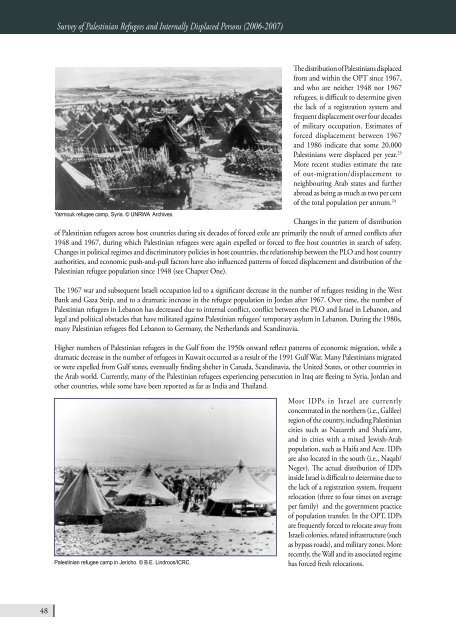BADIL Resource Center for Palestinian Residency and Refugee
BADIL Resource Center for Palestinian Residency and Refugee
BADIL Resource Center for Palestinian Residency and Refugee
You also want an ePaper? Increase the reach of your titles
YUMPU automatically turns print PDFs into web optimized ePapers that Google loves.
48<br />
Survey of <strong>Palestinian</strong> <strong>Refugee</strong>s <strong>and</strong> Internally Displaced Persons (2006-2007)<br />
Yarmouk refugee camp, Syria. © UNRWA Archives.<br />
Thedistributionof<strong>Palestinian</strong>sdisplaced<br />
from <strong>and</strong> within the OPT since 1967,<br />
<strong>and</strong> who are neither 1948 nor 1967<br />
refugees, is difficult to determine given<br />
the lack of a registration system <strong>and</strong><br />
frequent displacement over four decades<br />
of military occupation. Estimates of<br />
<strong>for</strong>ced displacement between 1967<br />
<strong>and</strong> 1986 indicate that some 20,000<br />
<strong>Palestinian</strong>s were displaced per year. 23<br />
More recent studies estimate the rate<br />
of out-migration/displacement to<br />
neighbouring Arab states <strong>and</strong> further<br />
abroad as being as much as two per cent<br />
of the total population per annum. 24<br />
Changes in the pattern of distribution<br />
of <strong>Palestinian</strong> refugees across host countries during six decades of <strong>for</strong>ced exile are primarily the result of armed conflicts after<br />
1948 <strong>and</strong> 1967, during which <strong>Palestinian</strong> refugees were again expelled or <strong>for</strong>ced to flee host countries in search of safety.<br />
Changes in political regimes <strong>and</strong> discriminatory policies in host countries, the relationship between the PLO <strong>and</strong> host country<br />
authorities, <strong>and</strong> economic push-<strong>and</strong>-pull factors have also influenced patterns of <strong>for</strong>ced displacement <strong>and</strong> distribution of the<br />
<strong>Palestinian</strong> refugee population since 1948 (see Chapter One).<br />
The 1967 war <strong>and</strong> subsequent Israeli occupation led to a significant decrease in the number of refugees residing in the West<br />
Bank <strong>and</strong> Gaza Strip, <strong>and</strong> to a dramatic increase in the refugee population in Jordan after 1967. Over time, the number of<br />
<strong>Palestinian</strong> refugees in Lebanon has decreased due to internal conflict, conflict between the PLO <strong>and</strong> Israel in Lebanon, <strong>and</strong><br />
legal <strong>and</strong> political obstacles that have militated against <strong>Palestinian</strong> refugees’ temporary asylum in Lebanon. During the 1980s,<br />
many <strong>Palestinian</strong> refugees fled Lebanon to Germany, the Netherl<strong>and</strong>s <strong>and</strong> Sc<strong>and</strong>inavia.<br />
Higher numbers of <strong>Palestinian</strong> refugees in the Gulf from the 1950s onward reflect patterns of economic migration, while a<br />
dramatic decrease in the number of refugees in Kuwait occurred as a result of the 1991 Gulf War. Many <strong>Palestinian</strong>s migrated<br />
or were expelled from Gulf states, eventually finding shelter in Canada, Sc<strong>and</strong>inavia, the United States, or other countries in<br />
the Arab world. Currently, many of the <strong>Palestinian</strong> refugees experiencing persecution in Iraq are fleeing to Syria, Jordan <strong>and</strong><br />
other countries, while some have been reported as far as India <strong>and</strong> Thail<strong>and</strong>.<br />
<strong>Palestinian</strong> refugee camp in Jericho. © B.E. Lindroos/ICRC.<br />
Most IDPs in Israel are currently<br />
concentrated in the northern (i.e., Galilee)<br />
region of the country, including <strong>Palestinian</strong><br />
cities such as Nazareth <strong>and</strong> Shafa’amr,<br />
<strong>and</strong> in cities with a mixed Jewish-Arab<br />
population, such as Haifa <strong>and</strong> Acre. IDPs<br />
are also located in the south (i.e., Naqab/<br />
Negev). The actual distribution of IDPs<br />
inside Israel is difficult to determine due to<br />
the lack of a registration system, frequent<br />
relocation (three to four times on average<br />
per family) <strong>and</strong> the government practice<br />
of population transfer. In the OPT, IDPs<br />
are frequently <strong>for</strong>ced to relocate away from<br />
Israeli colonies, related infrastructure (such<br />
as bypass roads), <strong>and</strong> military zones. More<br />
recently, the Wall <strong>and</strong> its associated regime<br />
has <strong>for</strong>ced fresh relocations.

















